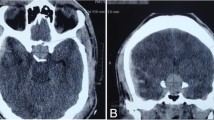Abstract
A very small proportion of hypopituitarism is due to head trauma, which may have occurred from days to years earlier. In the literature we found only three cases (two males, one female) of post-traumatic hypopituitarism in whom the hormone deficiency was claimed to be restricted to the gonadotrophs and considered to be permanent after a period of follow-up ranging from less than one year to four years. Here we describe a 26 yr-old male patient who, eight years after a motorcycle accident, was evaluated for hypogonadism and followed-up for three years. Serum testosterone, basal and GnRH-stimulated FSH and LH remained undetectable over the first 22 months of follow-up. Then, basal and GnRH-stimulated gonadotropins moved progressively into the normal range. Basal and dynamic evaluation of the other anterior pituitary hormones was persistently normal. At the 15th month of follow-up there was a change in the pituitary CT scan, presumably due to pituitary revascularization. Therefore, our patient disproves that post-traumatic isolated gonadotropin deficiency is irreversible.
Similar content being viewed by others
References
Ferrari C., Crosignani P.G. Ovarian failure without gonadotropin elevation in a patient with post-traumatic isolated hypogonadotropic hypogonadism. Eur. J. Obstet. Gyn. R. B. 21: 241, 1986.
Fok A.C.K., Isakok F.H.M., Sum C.F., Cheah J.S. Restoration of spermatogenesis with pulsatile gonadotropin releasing hormone therapy in hypogonadotropic hypogonadism of traumatic etiology. Aust. N.Z. J. Med. 19: 354, 1989.
Canale D., Giorgi P.M., Pierantoni M.C., Gasperi M., Macchia E., Martino E. Post- traumatic selective hypognadotropic hypogonadism: a case report. J. Endocrinol. Invest. 17(suppl. 1): 93, 1994 (abstract).
Thodon E., Asa S.L., Kontogeorgos G., Kovacs K., Howat E., Ezzat S. Lymphocytic hypophysitis: clinicopathological findings. J. Clin. Endocrinol. Metab., 80: 2302, 1995.
Milligan S.A., Katz M.S., Graven P.C., Strandberg I.A., Russel I.J., Becker R.A. Toxoplasmosis presenting as pan hypopituitarism in a patient with the acquired immune deficiency syndrome. Am. J. Med. 77: 760, 1984.
Ferreiro J., Vinters H.V. Pathology of the pituitary gland in patients with the acquired immune deficiency syndrome (AIDS). Pathology 20: 211, 1988.
Sullivan W.M., Kelley G., O’Connor P.G., Dickey P.S., Kim J.H., Robbins R., et al. Hypopituitarism associated with a hypothalamic CMV infection in a patient with AIDS. Am. J. Med. 92: 221, 1992.
Dobs A.S., Depsey M.A., Ladenson P.W., Polk B.F. Endocrine disorders in men infected with human immunodeficiency virus. Am. J. Med. 84: 611, 1988.
Lebovitz H.E., Baron M.A. Empty sella. In: Bardin C.W., (Ed.) Current therapy in Endocrinology and Metabolism, ed. 5. Mosby, St. Louis, MO, 1994, p. 34.
Edwards O.M., Clark J.D.A Post-traumatic hypopituitarism. Six cases and review of the literature. Medicine (Baltimore) 65: 281, 1986.
Lim H.S., Ang B.K., Ngim R.C.K. Hypopituitarism following head injury. A case report. Ann. Acad. Med. Singapore 851, 1990.
Valenta L.B., de Feo D.R. Post-traumatic hypopituitarism due to a hypothalamic lesion. Am. J. Med. 68: 614, 1980.
Escamilla R.F., Lisser H. Simmonds disease. J. Clin. Endocrinol. 2: 65, 1942.
Altman R., Pruzanski W. Post-traumatic hypopituitarism. Ann. Intern. Med. 55: 149, 1961.
Daniel P.M., Prichard M.M.L., Triep C.S. Traumatic infarction of the anterior lobe of the pituitary gland. Lancet 2: 927, 1959.
Ceballos R. Pituitary changes in head trauma. Analysis of 102 consecutive cases of head injury. Ala. J. Med. Sci. 3: 185, 1966.
Crompton M.R. Hypothalamic lesions following closed head injury. Brain 94: 165, 1971.
Kornblum R.N., Fisher R.S. Pituitary lesions in craniocerebral injuries. Arch. Path. 88: 242, 1969.
Eiholzer U., Zachmann M., Gnehm H.E., Prader A. Recovery from post-traumatic anterior pituitary insufficiency. Eur. J. Pediatr. 145: 128, 1986.
Iglesias P., Gómez-Pan A., Díez J.J. Spontaneous recovery from post-traumatic hypopituitarism. J. Endocrinol. Invest. 19: 320, 1996.
Benvenga S., Lo Giudice F., Ruggeri R.M. Central hypothyroidism subsequent to head trauma. J. Endocrinol. Invest. 20 (suppl. to n. 4): 22, 1997 (abstract).
Author information
Authors and Affiliations
Rights and permissions
About this article
Cite this article
Benvenga, S., Lo Giudice, F., Campennì, A. et al. Post-traumatic selective hypogonadotropic hypogonadism. J Endocrinol Invest 20, 675–680 (1997). https://doi.org/10.1007/BF03348031
Accepted:
Published:
Issue Date:
DOI: https://doi.org/10.1007/BF03348031




